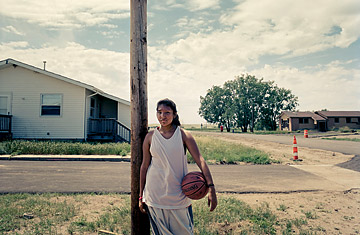
Spirit Grass, 13, is part of a family of six in Thunder Butte, S.D., who until recently survived on $3,500 a year.
(3 of 4)
The results were, to put it mildly, mixed. Families who moved to less poor neighborhoods generally saw improvements in mental health and feelings of safety but made few gains in income and employment. Kids did no better in school, and while girls tended to be better off socially, boys were more likely to show behavioral problems. One of the conclusions of Moving to Opportunity and similar programs has been that a neighborhood is largely the product of its residents' social connections, and while the networks of poor communities may at times hinder escape from poverty, they also often provide a key source of support.
The current approach is to change neighborhoods from within. The highest-profile effort is Harlem Children's Zone in New York City--a child-centric initiative that strives to reach a critical mass of neighborhood families through more than a dozen coordinated programs, from prenatal care to job training for teens and adults. A series of federal programs are now awarding competitive grants to coalitions of local organizations doing similar neighborhood-based work, including in rural areas and on a Cheyenne reservation.
MYTH NO. 4: FOCUSING ON INDIVIDUALS IS THE KEY TO POVERTY ALLEVIATION
It's easy to frame poverty as an individual problem, but some of the highest-poverty pockets of the country are places that have been hit hardest by the collapse of decent-paying manufacturing jobs. To discount macroeconomic forces is to miss a big part of what drives U.S. poverty.
Since 1980, worker productivity has risen by 78% but full-time-worker pay, including fringe benefits, has grown by just half that. Less educated workers--those most prone to poverty--have fared the worst, according to MIT economist Frank Levy. Furthermore, while college-completion rates have grown substantially over the past generation, those gains are concentrated among richer families, as research by the University of Michigan's Patrick Wightman and Sheldon Danziger illustrates. The increasing price of college is a factor, as is the fact that, for the poor, taking time off work to be a student is often not an option. But the education gap between kids from rich and poor families has not only been growing but starts even before kindergarten. A good school in every neighborhood is surely one of the most powerful antipoverty programs imaginable, but enriching preschool may need to be part of the equation too.
MYTH NO. 5: POVERTY IS INEVITABLE
Imagine a policy that could cut the U.S. poverty rate in half. Turns out we already have one: it's called Social Security. Between the late '50s and mid-'70s, the poverty rate dropped from 22% to 11%, mostly because of a decrease in the destitute elderly. In 2010, just 9% of Americans 65 and older were poor, the lowest rate for any age group. Last year, the earned-income tax credit, which boosts the pay of low-wage workers, lifted 5.4 million people, including 3 million children, out of poverty. Economists Yonatan Ben-Shalom, Robert Moffitt and John Karl Scholz calculate that programs like cash assistance, food stamps and unemployment and disability insurance reduce the rate of poverty and near poverty by 14 percentage points a year.
